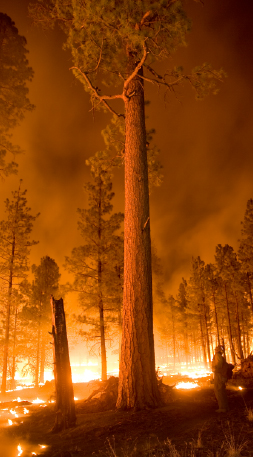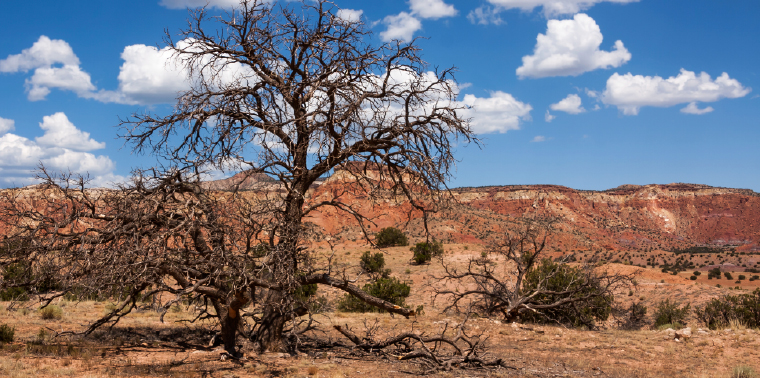January 19, 2015 — Junipers are hard to kill. Native to both warm, flooded tropics and the frigidly dry Arctic, it’s no surprise they come highly recommended for beginning landscapers. But in the dry summer heat of 2013, vast stands of northern New Mexico’s junipers were dying. And no one really knew why.
Park Williams, a bioclimatologist at Columbia University’s Lamont-Doherty Earth Observatory, might have an answer. For Williams, the likely explanation was drought. But not the sort of drought that experts usually measure, meaning a persistent lack of rain. Rather, this die-off may have been the result of a more subtle killer combo: too little moisture accompanied by too much heat.
Scientists are beginning to realize that this special kind of drought — and the number used to describe it — might hold the key to understanding, anticipating and potentially reducing the adverse impacts of drought in warm and arid places like the southwestern U.S. To Williams the number, known as vapor pressure deficit, is so important that he calls it the “unsung dictator of forests.”
“I talk to so many scientists who don’t think about the vapor pressure deficit, or don’t understand what it is,” he says. “But when we think about temperature influencing forests by increasing drought conditions, what we’re really thinking about is VPD.”
Using VPD as a predictor of drought could have many practical applications. For example, forest managers could know ahead of time that it may not be safe to carry out a prescribed burn. And the implications of the number go beyond forests. Advanced warning could give farmers a chance to intensify irrigation, or municipal water managers the foresight to curb water use before a drought hits. That information could provide a much-needed advantage in the uncertain climate of the future.
Look to the Sky
Traditional methods of tracking drought tend to focus on how much precipitation falls on land over time. VPD, however, looks to the sky.
“VPD is really easy,” Williams says. “All you need to know is the temperature and the humidity. And these are recorded at every weather station.”
By combining these two elements, VPD plots the unstable situation created when air holds less water vapor — or has a lower humidity — than is possible at a certain temperature. Warmer air wants to hold more water, whether it’s around to hold or not.
VPD can provide an idea of how much stress plants are under — which in turn provides an opportunity to anticipate and potentially mitigate the consequences.That relationship turns out to be rather important for plants. Like straws in a glass, plants can’t pipe up water on their own. A modest VPD acts like a giant thirsty mouth, sucking water vapor from the leaves. That suction in turn draws water into the roots and upward. The warmer the air — and the less moisture in it — the stronger that air will suck. If this negative pressure is extremely high, as it was over northern New Mexico for several days during the summer of 2013, plants can be forced to pipe water too quickly. Even for a tough species like a juniper, known for its strong water-transporting system, cells can collapse, damaging or killing the tree.
By putting a number to this sucking force, VPD can provide an idea of how much stress plants are under — which in turn provides an opportunity to anticipate and potentially mitigate the consequences.
Wildfire, pests and forest health
Williams set up shop at the Los Alamos National Laboratory in northern New Mexico in 2011. That summer, he says, unusually warm and dry air drove VPD about 20 percent higher than the historical average. The result was tremendous stress on forests as trees already troubled by insects and disease struggled to hold water. By year’s end, thousands of acres of forest had succumbed with no sign of relief. Wildfires quickly engulfed millions of acres of VPD-stressed trees across the vulnerable Southwest, breaking records for the largest or most devastating fires ever recorded in Texas, Arizona and New Mexico, and causing over a billion dollars in damage.

By providing an indicator of plant stress, VPD can help alert land managers to high-fire-risk conditions. Photo by Kari Greer/USFS Gila National Forest (Flickr/Creative Commons).
By describing the relationships among heat, air moisture and plant stress, VPD underscores that even a small amount of warming in a dry atmosphere can catalyze a cascade of environmental effects, such as these wildfires. That points to a troubling future for forests in the Southwest, where scientists have “high confidence” that global warming will continue heating the region, according to the 2013 National Climate Assessment. And that’s just the beginning.
In a 2012 study, Williams and his colleagues looked at past tree ring samples from the Southwest in the context of both past droughts and climate model projections of VPD. What they found wasn’t pretty. It suggests that as warming temperatures drive up VPD, pests and wildfires will weigh more and more on the health of forests. Devastating droughts that were once blessedly rare may become commonplace by mid-century.
But a future of high VPD isn’t limited to the Southwest. Because VPD rises exponentially with warming temperatures, anywhere hot and dry will feel a greater impact.
“Places like the U.S. Southwest — or the Mediterranean, or the mountains of Mexico — that are fairly arid and already warm, if you increase temperature in any of these places, then you really change the atmospheric conditions in a major way,” Williams says.
Climate models estimate that around the world, average VPD in warm seasons could rise as much as 3.6 percent each decade, according to the study. Williams says that the Southwest could see an increase of 40 percent by 2100, twice as much as the devastating jump in New Mexico’s fiery 2011.
“By the end of the century,” Williams says, “Forests will be living in an entirely different world.”
A New Forecasting Tool
The stark projections have inspired scientists to harness the power of VPD to not only map current droughts, but also to improve understanding and ability to predict how drought develops in hopes of building resiliency to this slow and subtle disaster.
Because VPD taps atmospheric components, which are poorly studied, Granger says the measure shows promise as a tool for unraveling how drought begins.Deep in the driest part of Southern California, just north of Los Angeles, scientists at NASA’s Jet Propulsion Laboratory are tracking VPD across the West for the first time. In a recent study, JPL scientist Stephanie Granger and fellow researchers mined over 100 years of temperature and moisture data recorded at weather stations, including the devastatingly dry 2011 and 2012. Their research, presented at the annual meeting of the American Meteorological Society this January, tests how including variables like VPD could improve drought monitoring.
Because VPD taps atmospheric components, which are poorly studied, Granger says the measure shows promise as a tool for unraveling how drought begins. Plus, she says, her team’s research suggests that tracking VPD can give decision-makers valuable advance warning of droughts.
“For instance, in the 2012 drought in the Central Plains we see that the atmospheric components [of VPD] seemed to show that drought was coming before, say, the U.S. Drought Monitor picked it up,” she says.
In the fall of 2014, Granger also advised a student project that used VPD to answer some of the same questions. But rather than mining weather station data, which can take months to process, the students calculated and mapped VPD from satellite data delivered almost in real time.
Brian Fuchs, a climatologist at the National Drought Mitigation Center, is encouraged by the prospects of this new capability. As an author of the U.S. Drought Monitor, which produces weekly drought information for everyone from farmers and ranchers to federal government workers, Fuchs points out that timely observations can help the U.S. Drought Monitor provide better information about current conditions.
“As our climate starts to change over time, it may be that temperature will play a bigger role in future droughts.” — Stephanie GrangerWhile VPD isn’t one of the dozens of indicators it employs to monitor those conditions, the U.S. Drought Monitor and other organizations could add VPD to their toolbox. That would strengthen their understanding of plant stress, and even provide direct observations for more robust near-future outlooks. The latter is currently the responsibility of the Climate Prediction Center, Fuchs says, which relies on imperfect models and past data — not real-time observations — to forecast drought conditions.
If satellites spot several days of exceptionally high VPD over a region, Granger’s colleague Ali Behrangi explains, forecasters know the atmosphere is sucking lots of water from plants. So even if precipitation, soil moisture and reservoir levels appear normal, decision-makers can prepare for drought.
“As our climate starts to change over time, it may be that temperature will play a bigger role in future droughts,” Granger says.
With VPD in the toolbox, however, scientists and policy-makers alike will be better equipped to anticipate and respond to those droughts. That could help minimize the devastation of wildfire, impacts on food and water security, and more. In fact, when it comes to the promise of the Southwest’s most important number, researchers are just warming up. ![]()
Ensia shares solutions-focused stories free of charge through our online magazine and partner media. That means audiences around the world have ready access to stories that can — and do — help them shape a better future. If you value our work, please show your support today.
Yes, I'll support Ensia!

Might an integral of VPD over time yield a Soil Moisture Deficit, which would be an even more accurate predictor of fire risk?